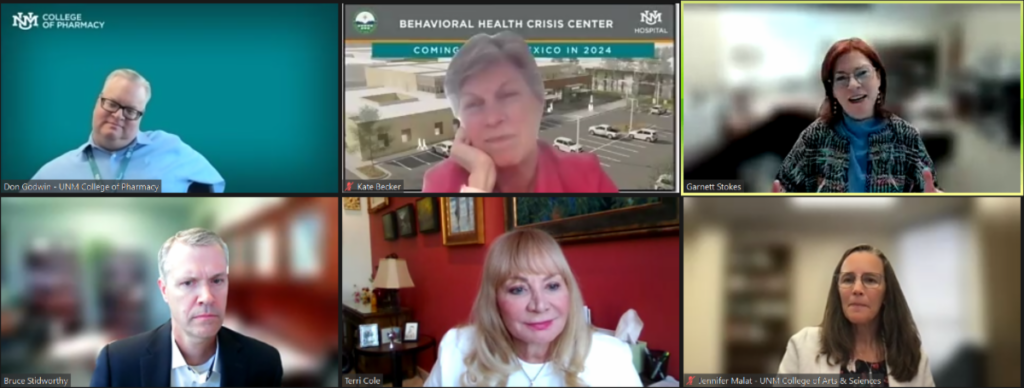 Yesterday afternoon, the Chamber hosted high-level University of New Mexico leaders to discuss two important upcoming ballot initiatives in a virtual event: general obligation bonds, or GO bonds, and the Bernalillo County mill levy.
Yesterday afternoon, the Chamber hosted high-level University of New Mexico leaders to discuss two important upcoming ballot initiatives in a virtual event: general obligation bonds, or GO bonds, and the Bernalillo County mill levy.
At the Chamber’s Business Beat event on Zoom, University President Garnett Stokes said both of these funding sources are critical for supporting the university in its commitment to serving the state.
Stokes said UNM has received a significant $360 million in funding since the 2008 GO bond and gave an overview of some of the highlights:
- The UNM Comprehensive Cancer Center, one of the nation’s 60 premier cancer centers.
- The UNM Film and Digital Media building, conveniently located near Netflix to help build a “New Mexican Hollywood.”
- The Domenici Center for Health Sciences Education that fosters collaboration across different disciplines and supports research.
- An ROTC facility with classrooms, offices and student areas to support training and foster team-building.
Stokes also gave a preview of some projects in the works:
- Health Sciences Center’s Nursing & Population Health building, set to open this summer to allow nursing and population health to be housed in one location and free up space for pharmacy to consolidate.
- The Center for Collaborative Arts & Technology that provides a signature space for the College of Fine Arts, which is currently spread across 13 buildings.
- Other critical investments at UNM’s branch campuses across the state.
Stokes turned it over to University of New Mexico Hospitals CEO Kate Becker to talk about the mill levy and its importance to UNMH’s critical system of care. Becker highlighted the hospital’s “ones and onlies” – the state’s only academic medical center, its only Level One Trauma facility and the only hub for certain pediatric specialties. Of the 130 trauma centers in the nation, UNMH is in the top 10% for busyness and among the top 10 hospitals for severity of patients’ injuries. “We are the safety net – literally – for trauma in New Mexico,” Becker said.
And yet, the hospital system is beating the odds with a mortality rate that shows UNMH is helping more patients recover than at most other hospitals.
Becker said UNMH is also home to the state’s only children’s hospital and the Albuquerque-area IHS hospital – and it’s growing in its ability to provide 24/7 behavioral health care with a new center set to open this summer. It’s the only hospital in the nation that holds all of these designations and serves all of these needs, and it employs nearly 8,000 people across the metro area.
Becker concluded by reminding participants that the mill levy is key to helping keep the hospital operating and won’t increase taxes for residents, and she encouraged them to vote “yes” on the initiative.
Next, UNM College of Pharmacy Dean Don Godwin spoke to the college’s renovation. Its current building opened in 1975, and thanks to its programs’ growth, it now sprawls across seven buildings. The goal is a remodeling, not a new building, to provide some important updates to improve students’ experiences.
Godwin explained the importance of the College of Pharmacy: it supports not only education and training for the next generation of pharmacists, but also research, collaborative health care, strategies for addressing public health challenges and policy work as well. To this end, the remodel will provide the college with improved technology, better classrooms and student spaces to foster collaboration, and upgraded HVAC, electrical and IT systems for improved efficiency – the building is currently the most expensive building to run due to its current inefficiencies.
Thanks to the upcoming move of the nursing school to the new HSC building, the College of Pharmacy will also gain some space in the building, consolidating it under three roofs instead of seven – all without encroaching on the university’s limited parking. All told, the project will cost $60 million to complete for March 2027 occupancy.
College of Arts & Sciences Dean Jennifer Malat addressed the university’s last major project: a full replacement of the Humanities & Social Sciences Complex. The building is home to the natural sciences, social sciences and humanities’ 23 departments, 70 undergrad programs, 30 grad programs and lots of museum space. The building, which was built in 1971, is in constant need of repairs, with safety issues, poor energy efficiency and flooding problems, but it’s also not set up for the collaboration students need to be successful and has outdated classrooms, she said.
Goals for the new facility include more opportunities for enhanced collaboration and improved student spaces that will help students feel they belong – improvements she said will boost the recruitment and retention of students and faculty alike. “I want students to see we’re as invested in their future as they are,” Malat said.
She also emphasized that the building serves far more than the nearly 2,000 students majoring in the humanities and social sciences programs. It has a greater impact in helping many other students build skills and develop new perspectives, no matter what field they’re in.
GACC Board of Directors Chair Bruce Stidworthy asked the first question of Q&A: what needs will the bond and mill levy serve? Becker said that without the mill levy, UNMH would need to cut about 10% of its critical services – a blow given all of the needs UNMH is uniquely positioned to meet. Unlike the capital projects the GO bonds fund, the mill levy funds operations and maintenance, Becker explained.
Meanwhile, Godwin said the proposed renovations will enable the College of Pharmacy to give the state more urgently-needed providers to meet residents’ needs; Malat said the new humanities building will improve students’ experience so they feel they belong and want to stay to graduate.
GACC President and CEO Terri Cole asked how this funding will help address our state’s provider shortage. Becker answered that it’s not just about classroom learning – UNMH also provides a critical on-the-job clinical environment to allow residencies to expand and boost the health care workforce.
Godwin agreed and added these investments will boost UNM’s profile as well. “I think great facilities will attract great faculty… and that’s going to attract great students,” he said.
Many thanks to President Stokes, Dr. Becker and Deans Malat and Godwin for taking the time to break down what this fall’s ballot means to our flagship university, our Albuquerque-area community and our state. As November’s election gets closer, we’ll be sure to remind the business community of its importance – keep an eye out.
If you weren’t able to join us live yesterday, you can watch the recorded event here.




